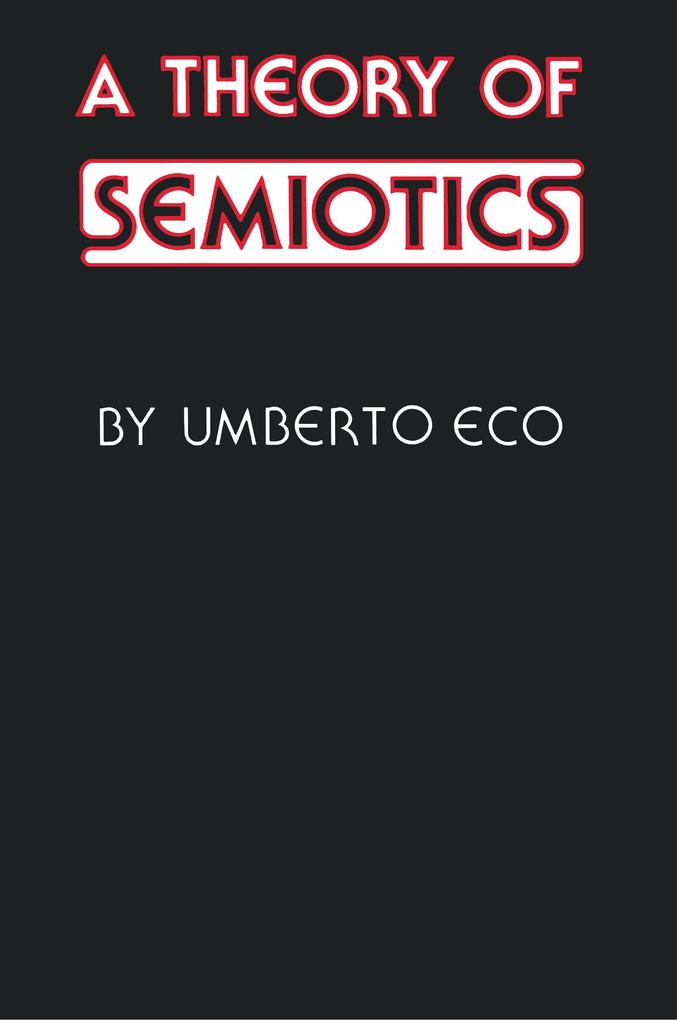
Zustellung: Fr, 20.12. - Sa, 28.12.
Versand in 3-4 Wochen
VersandkostenfreiBestellen & in Filiale abholen:
'Eco's very erudite and provocative book draws on philosophy, linguistics, sociology, anthropology, and aesthetics and refers to a wide range of scholarship, both European and American. It raises many fascinating questions which merit considerable probing.'-Language in Society
Inhaltsverzeichnis
Foreword
Note on graphic conventions
0. Introduction-Toward a Logic of Culture
0.1. Design for a semiotic theory
0.2. 'Semiotics': field or discipline?
0.3. Communication and/or signification
0.4. Political boundaries: the field
0.5. Natural boundaries: two definitions of semiotics
0.6. Natural boundaries: inference and signification
0.7. Natural boundaries; the lower threshold
0.8. Natural boundaries: the upper threshold
0.9. Epistemological boundaries
1. Signification and Communication
1.1. An elementary communicational model
1.2. Systems and codes
1.3. The s-code as structure
1.4. Information, communication, signification
2. Theory of Codes
2.1. The sign-function
2.2. Expression and content
2.3. Denotation and connotation
2.4. Message and text
2.5 Content and referent
2.6. Meaning as cultural unit
2.7. The interpretant
2.8. The semantic system
2.9. The semantic markers and the sememe
2.10. The KF model
2.11. A revised semantic model
2.12. The model "Q"
2.13. The format of the semantic space
2.14. Overcoding and undercoding
2.15. The interplay of codes and the message as an open form
3. Theory of Sign Production
3.1. A general survey
3.2. Semiotic and factual statements
3.3. Mentioning
3.4 The prolem of a typology of signs
3.5. Critique of iconism
3.6. A typology of modes of production
3.7. The aesthetic text as invention
3.8. The rhetorical labor
3.9. Ideological code switching
4. The Subject of Semiotics
References
Index of authors
Index of subjects
Note on graphic conventions
0. Introduction-Toward a Logic of Culture
0.1. Design for a semiotic theory
0.2. 'Semiotics': field or discipline?
0.3. Communication and/or signification
0.4. Political boundaries: the field
0.5. Natural boundaries: two definitions of semiotics
0.6. Natural boundaries: inference and signification
0.7. Natural boundaries; the lower threshold
0.8. Natural boundaries: the upper threshold
0.9. Epistemological boundaries
1. Signification and Communication
1.1. An elementary communicational model
1.2. Systems and codes
1.3. The s-code as structure
1.4. Information, communication, signification
2. Theory of Codes
2.1. The sign-function
2.2. Expression and content
2.3. Denotation and connotation
2.4. Message and text
2.5 Content and referent
2.6. Meaning as cultural unit
2.7. The interpretant
2.8. The semantic system
2.9. The semantic markers and the sememe
2.10. The KF model
2.11. A revised semantic model
2.12. The model "Q"
2.13. The format of the semantic space
2.14. Overcoding and undercoding
2.15. The interplay of codes and the message as an open form
3. Theory of Sign Production
3.1. A general survey
3.2. Semiotic and factual statements
3.3. Mentioning
3.4 The prolem of a typology of signs
3.5. Critique of iconism
3.6. A typology of modes of production
3.7. The aesthetic text as invention
3.8. The rhetorical labor
3.9. Ideological code switching
4. The Subject of Semiotics
References
Index of authors
Index of subjects
Produktdetails
Erscheinungsdatum
22. November 1978
Sprache
englisch
Seitenanzahl
368
Autor/Autorin
Umberto Eco
Verlag/Hersteller
Produktart
kartoniert
Gewicht
541 g
Größe (L/B/H)
229/152/21 mm
ISBN
9780253202178
Entdecken Sie mehr
Bewertungen
0 Bewertungen
Es wurden noch keine Bewertungen abgegeben. Schreiben Sie die erste Bewertung zu "A Theory of Semiotics" und helfen Sie damit anderen bei der Kaufentscheidung.










